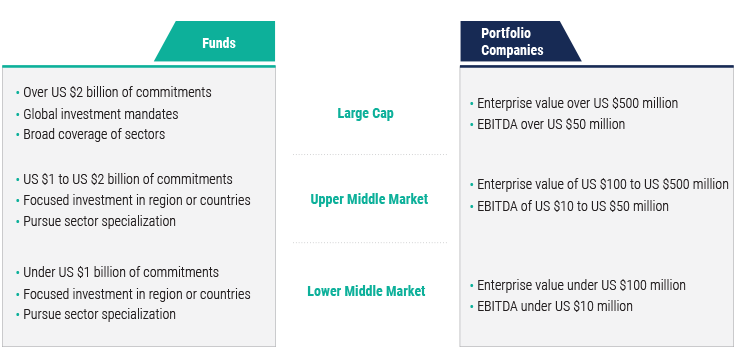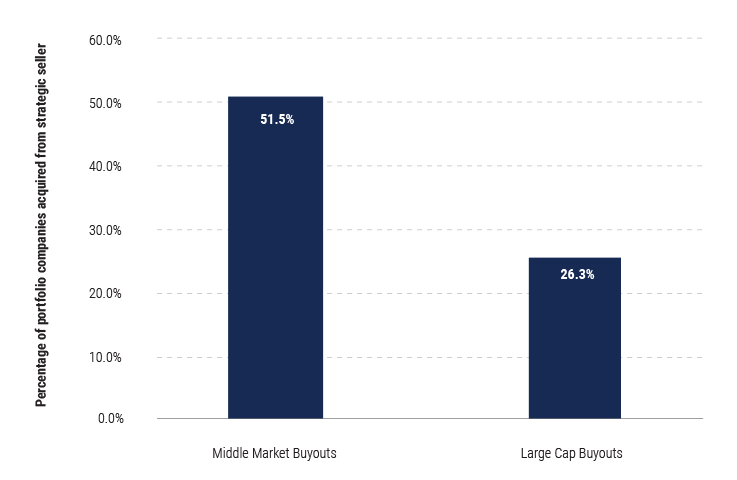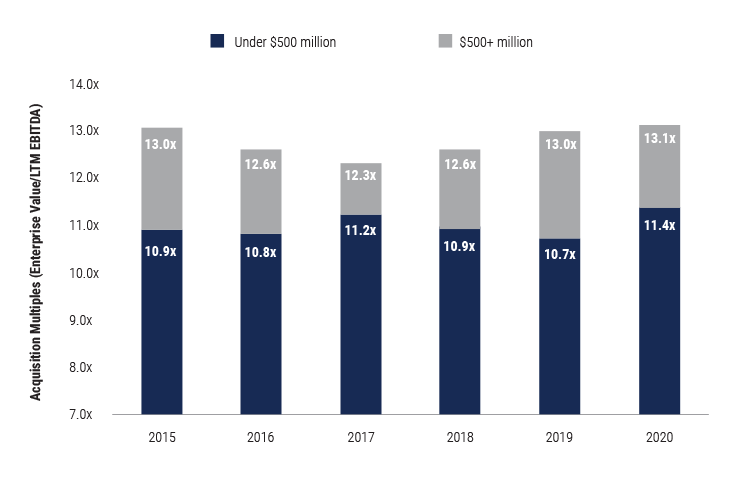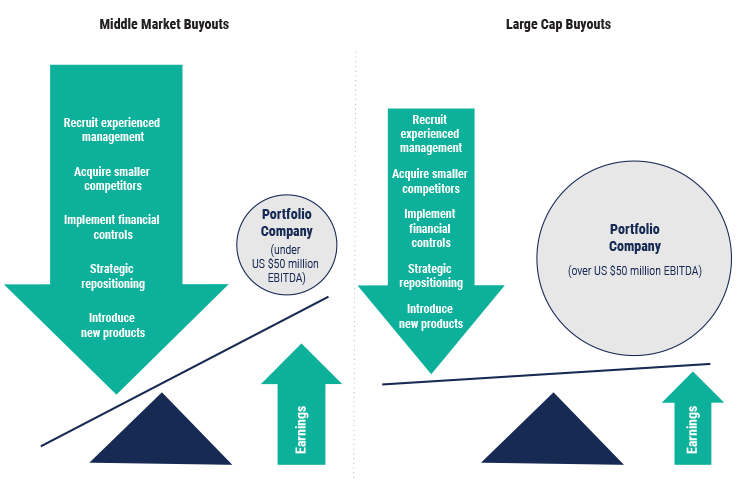Leveraged buyout fund managers controlling tens of billions of dollars appear to be focusing more and more on middle-market business targets – and we believe they have several good reasons for doing so. Here’s one: Middle-market funds posted net internal rates of return (IRRs) that were 90 basis points higher than those of large-cap funds issued since the end of the global financial crisis in 2009 through 2017-vintage funds that largely completed building their portfolios (see chart, “Middle-Market IRR Has Outperformed vs. Large-Cap Buyout Funds”). That’s the case across median-quartile mid-cap funds and even lower-quartile funds. More interesting is that top-quartile middle-market funds posted net IRRs that were 270 basis points higher than for large-cap funds.
These results show that size does matter, and the successful aren’t always the biggest players. A recent Preqin article, “Huge Buyouts Make Good Headlines, But Are They Worth it?”1 bears this out, making the point that as transaction sizes grow, a kind of “winner’s curse” may arise: The winning bids can end up with potentially overpriced assets that struggle to outperform the median IRR of funds not involved in these deals. Preqin’s research revealed regular underperformance of funds that participated in transactions valued above $1 billion from 2011 to 2017 versus those that stuck to smaller deal sizes.
Middle-Market IRR Has Outperformed vs. Large-Cap Buyout Funds
(Vintage 2009-2018)

Investors often sort listed equities into three major categories: large-capitalization stocks (total equity values above $10 billion), small-cap companies (less than $2 billion of capitalization), and mid-caps that fall in between.
In the private markets, the PineBridge Private Funds Group (“PineBridge”) distinguishes a large-cap private-market company by drawing a line at $500 million of enterprise value or EBITDA over $50 million, and views a pool of capital with over $2 billion of commitments and the ability to invest globally across industries as a large-cap focused fund. What falls below those figures we broadly define as the middle market.
And further distinctions can help investors observe how differences in the size of investments can lead to considerable variations in strategy – and performance. A split can be made between the upper middle market, which features companies with $100 million to $500 million of enterprise value, and their smaller peers in the lower middle market. As the size shrinks, a fund manager’s focus typically narrows, but the two portions of the middle market are similar when contrasted with large-cap buyouts.

Differentiated sourcing
Historically, the private equity industry started by addressing inadequacies in bloated private corporations, such as an unwillingness to make long-term plans; excessive spending on selling, general, and administrative (SG&A) expenses; and a lack of incentives for management to make improvements. This playbook can now apply to the middle market, where slightly over half of transactions involve a purchase from a strategic seller including a founder, family holder, or corporate parent (see chart, “More Middle-Market Portfolio Companies Are Acquired From Strategic Sellers”).
In contrast, just 26.3% of large-cap sponsors’ portfolio companies were sourced from strategic sellers such as family-owned businesses or neglected divisions of larger conglomerates. The vast majority of large-cap buyouts came from financial sponsors and buyouts of public companies whose asset values were already being maximized. PineBridge believes this is due in large part to the impact of buyout firms themselves: Their continuing influence has meant public and private companies are generally better-run today. Acquiring a business that just spent years under scrutiny by public shareholders or another private equity firm leads to a critical question: What upside is left for the large-cap purchaser?
More Middle-Market Portfolio Companies Are Acquired From Strategic Sellers
(1 January 2015–31 December 2020)

Lower starting valuations in the middle market
Lower valuations for acquisitions are another attraction for middle-market funds. Over the past six years, valuation multiples for global acquisitions of companies with an enterprise value under US$500 million were 10.7x to 11.4x last-12-month (LTM) EBITDA, which is 16% lower on average than the range of 12.3x to 13.1x for larger companies (see chart, “Valuation Multiples for Middle-Market Buyouts Are Compelling vs. Large-Cap”). PineBridge believes that portfolio company cash flow is the critical mechanism. If cash flow is the key to repay considerable leverage in a buyout, then paying extra for large-cap EBITDA puts the leverage strategy at a disadvantage when matched against the opportunity to acquire cheaper middle-market businesses.
Valuation Multiples for Middle-Market Buyouts Are Compelling vs. Large-Cap
Implied enterprise value/EBITDA multiples based on transaction size

Unequal influence for value-creation strategies
In addition to the advantage of lower entry valuations, PineBridge observes that middle-market acquisitions have tended to offer greater capacity for making value-added improvements to the business versus their large-cap counterparts. Strategies such as recruiting experienced management, implementing tighter financial controls, or introducing new products are techniques used to boost the value of a portfolio company whose EBITDA is under $50 million, and the expense of professionalizing these businesses is lower because it is applied against a smaller base of operations. In contrast, a large-cap sponsor cannot expect to make more than incremental enhancements to a newly acquired company’s current business plan, given that capable managers likely already occupy the C-suite.
The Potential Upside Is Generally Higher for Middle-Market Businesses vs. Large-Cap Buyout Businesses

Sustained outperformance potential
PineBridge believes that these factors help to explain the attractive performance of middle-market buyout opportunities since the global financial crisis ended in June 2009. We believe institutional investors that bypassed the middle market and instead concentrated assets in large-cap opportunities may have missed out on some of the structural advantages of middle-market buyouts, which may not have been evident with those larger deals.
PineBridge believes opportunities remain for investors considering the middle market’s fundamental strengths.
The Middle-Market Advantage
Private equity market segments offer different levels of attractiveness.
A Large and Growing Opportunity
Buyout funds with less than US$2 billion of capital employ different strategies than funds with higher capitalization.2
Since 2009, over twice as many middle-market funds raised globally versus large-cap funds.3
Historically, many financial sponsors exerted greater influence on companies with less than US$50 million of EBITDA, when compared to large-cap buyout portfolio companies.
Lower Valuations and Leverage
Valuations for global acquisitions of companies with US$500 million or less of enterprise value averaged 16% lower than for larger companies over the past six years.4
Buyouts of companies with less than US$50 million of EBITDA consistently use less leverage than buyouts of larger companies.5
Strong Performance
Top quartile of middle-market funds outperformed top quartile of large-cap funds by 270 bps since 2009.6
Distinct privately held assets allow middle-market PE to offer a lower correlation to the public markets and lower volatility than large market private equity.
As of 23 September 2021. For illustrative purposes only. Views are the opinion of the Private Funds Group, are valid only as of the date indicated, and are subject to change. There can be no assurance that these trends continue.
Footnotes
1 Source: Preqin Blog, “Huge Buyouts Make Good Headlines, But Are They Worth It?” (C. McGrath, 5 May 2021).
2 FactSet as of 23 September 2021. Represents all announced acquisitions globally.
3 Preqin as of 23 September 2021. Includes all buyout and growth equity funds raised since 2009 in Preqin database. There can be no assurance that any particular manager will pass due diligence, be approved by the investment committee, or otherwise be available to PFG.
4 FactSet as of 23 September 2021. Represents all announced acquisitions globally.
5 S&P Global Market Intelligence, Leveraged Commentary & Data, 4Q 2020, from 1 January 2014 through 31 December 2020.
6 Preqin database, retrieved on 23 September 2021. Represents query of pooled net fund returns in Cambridge database covered in the time periods set forth above. Net IRR here represents the internal rate of return to the limited partners net of all management fees, carried interest, and other fund expenses. PineBridge Private Funds Group investors would have additional fees, which may result in lower returns. For illustrative purposes only. Past performance is not indicative of future results.

